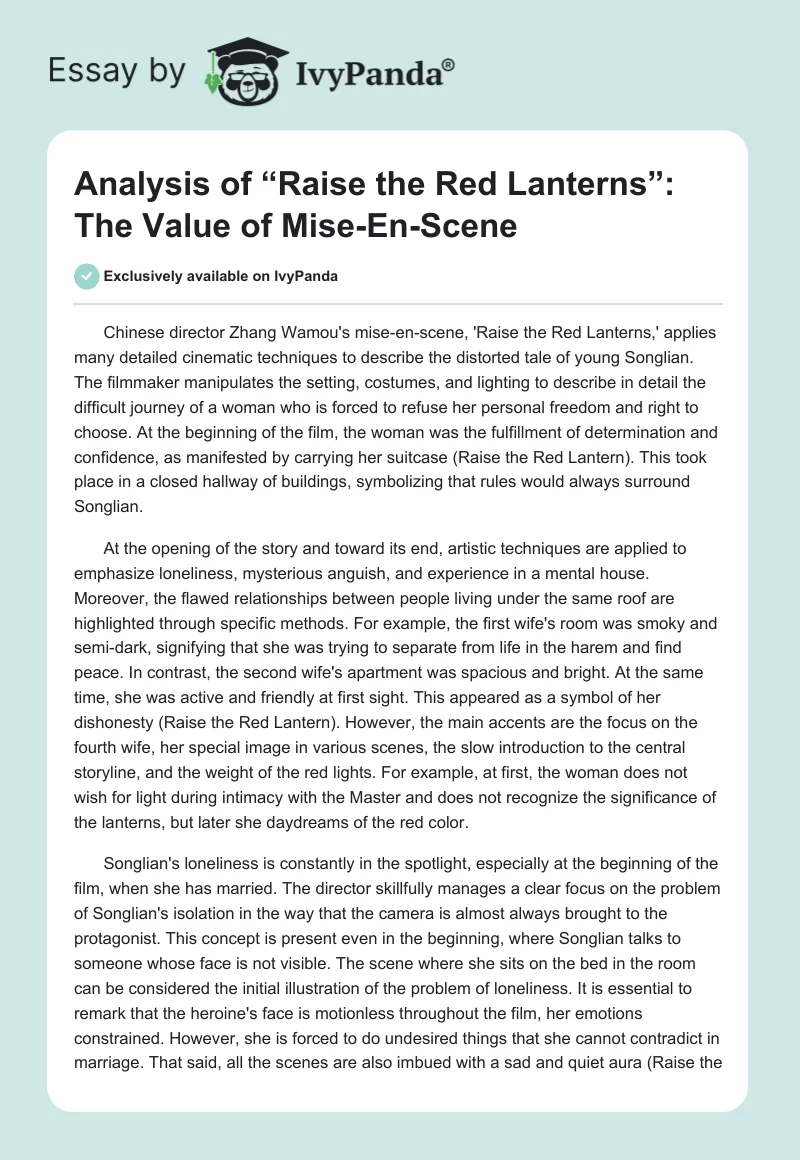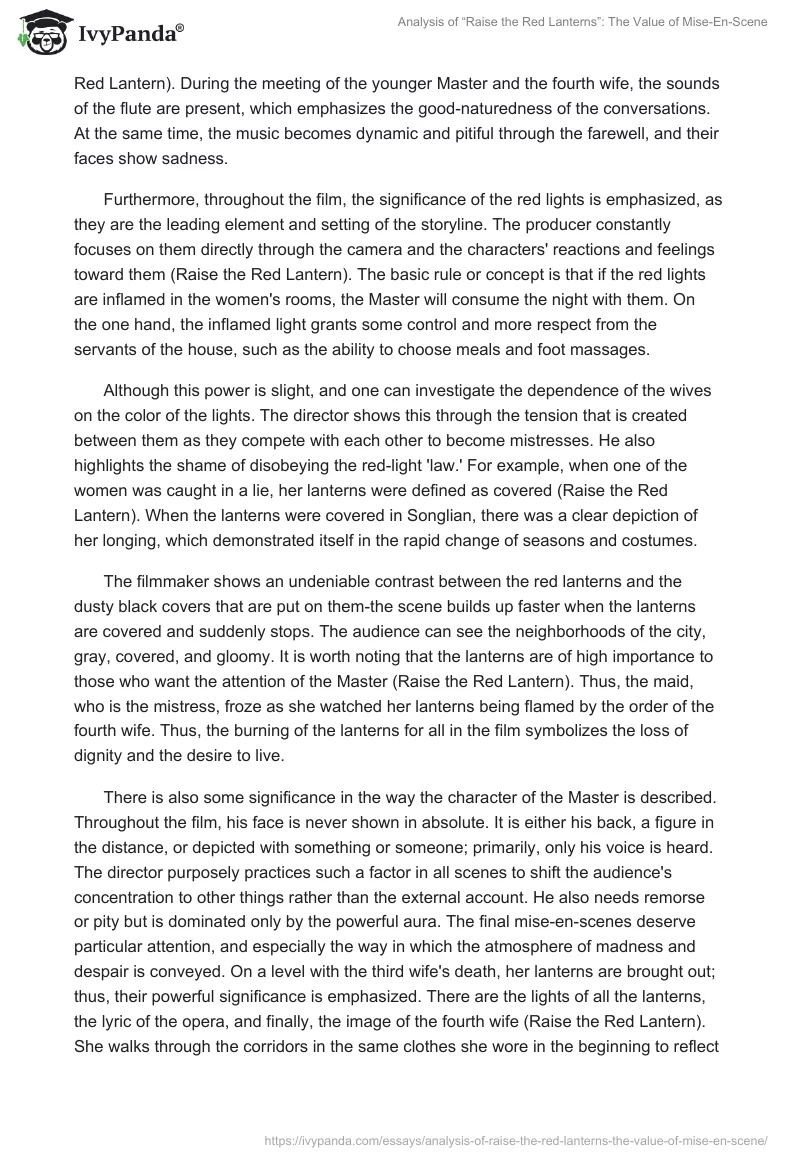Chinese director Zhang Wamou’s mise-en-scene, ‘Raise the Red Lanterns,’ applies many detailed cinematic techniques to describe the distorted tale of young Songlian. The filmmaker manipulates the setting, costumes, and lighting to describe in detail the difficult journey of a woman who is forced to refuse her personal freedom and right to choose. At the beginning of the film, the woman was the fulfillment of determination and confidence, as manifested by carrying her suitcase (Raise the Red Lantern). This took place in a closed hallway of buildings, symbolizing that rules would always surround Songlian.
At the opening of the story and toward its end, artistic techniques are applied to emphasize loneliness, mysterious anguish, and experience in a mental house. Moreover, the flawed relationships between people living under the same roof are highlighted through specific methods. For example, the first wife’s room was smoky and semi-dark, signifying that she was trying to separate from life in the harem and find peace. In contrast, the second wife’s apartment was spacious and bright. At the same time, she was active and friendly at first sight. This appeared as a symbol of her dishonesty (Raise the Red Lantern). However, the main accents are the focus on the fourth wife, her special image in various scenes, the slow introduction to the central storyline, and the weight of the red lights. For example, at first, the woman does not wish for light during intimacy with the Master and does not recognize the significance of the lanterns, but later she daydreams of the red color.
Songlian’s loneliness is constantly in the spotlight, especially at the beginning of the film, when she has married. The director skillfully manages a clear focus on the problem of Songlian’s isolation in the way that the camera is almost always brought to the protagonist. This concept is present even in the beginning, where Songlian talks to someone whose face is not visible. The scene where she sits on the bed in the room can be considered the initial illustration of the problem of loneliness. It is essential to remark that the heroine’s face is motionless throughout the film, her emotions constrained. However, she is forced to do undesired things that she cannot contradict in marriage. That said, all the scenes are also imbued with a sad and quiet aura (Raise the Red Lantern). During the meeting of the younger Master and the fourth wife, the sounds of the flute are present, which emphasizes the good-naturedness of the conversations. At the same time, the music becomes dynamic and pitiful through the farewell, and their faces show sadness.
Furthermore, throughout the film, the significance of the red lights is emphasized, as they are the leading element and setting of the storyline. The producer constantly focuses on them directly through the camera and the characters’ reactions and feelings toward them (Raise the Red Lantern). The basic rule or concept is that if the red lights are inflamed in the women’s rooms, the Master will consume the night with them. On the one hand, the inflamed light grants some control and more respect from the servants of the house, such as the ability to choose meals and foot massages.
Although this power is slight, and one can investigate the dependence of the wives on the color of the lights. The director shows this through the tension that is created between them as they compete with each other to become mistresses. He also highlights the shame of disobeying the red-light ‘law.’ For example, when one of the women was caught in a lie, her lanterns were defined as covered (Raise the Red Lantern). When the lanterns were covered in Songlian, there was a clear depiction of her longing, which demonstrated itself in the rapid change of seasons and costumes.
The filmmaker shows an undeniable contrast between the red lanterns and the dusty black covers that are put on them-the scene builds up faster when the lanterns are covered and suddenly stops. The audience can see the neighborhoods of the city, gray, covered, and gloomy. It is worth noting that the lanterns are of high importance to those who want the attention of the Master (Raise the Red Lantern). Thus, the maid, who is the mistress, froze as she watched her lanterns being flamed by the order of the fourth wife. Thus, the burning of the lanterns for all in the film symbolizes the loss of dignity and the desire to live.
There is also some significance in the way the character of the Master is described. Throughout the film, his face is never shown in absolute. It is either his back, a figure in the distance, or depicted with something or someone; primarily, only his voice is heard. The director purposely practices such a factor in all scenes to shift the audience’s concentration to other things rather than the external account. He also needs remorse or pity but is dominated only by the powerful aura. The final mise-en-scenes deserve particular attention, and especially the way in which the atmosphere of madness and despair is conveyed. On a level with the third wife’s death, her lanterns are brought out; thus, their powerful significance is emphasized. There are the lights of all the lanterns, the lyric of the opera, and finally, the image of the fourth wife (Raise the Red Lantern). She walks through the corridors in the same clothes she wore in the beginning to reflect equal innocence and vulnerability. During the film, though, Songlian chooses the best costumes to impress the Master and to brighten the lanterns in her house.
Thus, the audience is exposed to various cinematic techniques that portray the characters’ problems and disorders. With properly chosen musical accompaniment and camera accents, the atmosphere of the time is accurately conveyed. The relationship between the third and fourth wife changes, which is supplemented by different music. For example, when there is a sincere conversation, there are motifs of quiet and calm music to describe the atmosphere of benevolence. At the end of the film, operatic music performs during the wedding of the fifth wife and the Master, symbolizing the repetition of history (Raise the Red Lantern). Obviously, by depicting the fifth wife as sad at the beginning of the wedding, the author is trying to show her weakness and loneliness.
At the same time, a fourth crazy wife wanders nearby, sort of a warning of the possible dangers that will expect the new wife. The scenery and the costumes can also be attributed to the effective methods of the movie, as they illustrate in detail the Chinese culture of the time. Particular importance is placed on the lanterns, whose changing lighting is a leading factor, clearly demonstrating the characters’ relationships and attitudes.
Work Cited
Zhang, Yimou, directed. Raise the Red Lantern. Orion Classics, 1991


